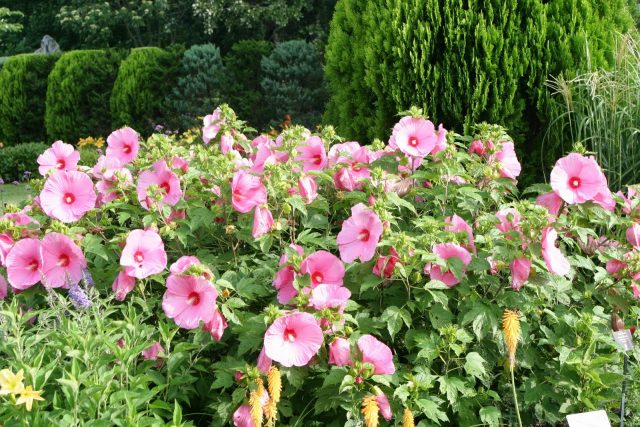Content
Hibiscus is most often considered as a purely indoor plant. However, experienced gardeners successfully grow this perennial crop in open ground. But for this you need to know exactly how garden hibiscus overwinters, depending on its variety. Otherwise, there is a risk of the plant dying at the first sustained frost. Therefore, it is worth understanding the wintering features of the plant so that it pleases with lush flowering and maintains a high vital potential for many years.

Garden hibiscus, like indoor hibiscus, belongs to the Malvaceae family.
Do all varieties of hibiscus need to be covered?
Not every variety of this perennial garden crop needs shelter. The most frost-resistant are herbaceous hybrids, since their above-ground part dies off completely with the arrival of the first cold weather and only resumes vegetation with the arrival of spring warmth. But the Syrian type of crop, which is also called tree-like, is capable of wintering without shelter only in the southern regions of the country.Moreover, this hibiscus needs not only insulation, but also preliminary preparation for the cold season. This accelerates the ripening of its young shoots, which improves winter hardiness.
How to prepare garden hibiscus for winter
To preserve garden hibiscus in winter, it is necessary to organize proper care of the plant throughout the end of the season. It includes several basic activities that are recommended to be strictly followed. Because only in this case can you expect that the plant will survive the winter well and begin the growing season in a timely manner in the spring.
Pruning garden hibiscus for the winter
To increase the frost resistance of perennials, pruning is necessary in late autumn. The procedure is recommended during the period when the air temperature drops to a level of -5-10 °C. At this time, all seed pods should be removed, and the shoots should be shortened by 10 cm. It is also necessary to pinch all side branches. This will stimulate the formation of young growth in sufficient quantities in the next season.

It is prohibited to form a crop crown in autumn
Watering and fertilizing
Caring for garden hibiscus in the fall also involves water-charging irrigation. To do this, you can use settled water. When moistening, the soaking of the soil in the root circle should be about 20 cm. It is recommended to carry out moisture-charging irrigation in advance, namely in mid-September.It is important that the air temperature remains above 0 °C at any time of the day. Otherwise, an ice crust may form on the surface of the soil, and this will impede air access to the underground part of the plant.
For successful wintering of tree hibiscus, proper feeding in the fall is also important. During this period, it is necessary to use monopotassium phosphate. It is recommended to use it at the rate of 9-15 g per 10 liters of water, depending on the age of the seedling. This feeding speeds up the recovery of garden hibiscus after flowering and helps it survive the winter well. Nitrogen fertilizers cannot be used at the end of the season, as they activate growth processes, which leads to a decrease in the frost resistance of the crop.
Fertilizing should be done when the soil is damp to avoid the possibility of burning the roots. Therefore, the procedure is recommended after rain or watering.
Mulching
One of the stages of preparing hibiscus for winter at the dacha is mulching the root circle. Insulation of the underground part must be carried out after moisture-charging irrigation. To do this, you can use humus or dry straw.
It is recommended to lay the mulch 10 cm thick. However, it should not come into contact with the trunk of the tree-like hibiscus, since during thaws the protective layer can cause the bark to warm up.
How to cover garden hibiscus for the winter
You need to start covering garden hibiscus for the winter with the arrival of stable frosts. To do this, you need to make a frame of wooden planks like a hut. This will prevent snow from accumulating at the top in winter, otherwise it could break the top of the seedling. After this, it is recommended to lay a layer of spruce branches on the structure and fix it.You can also use agrofibre, which needs to be wrapped around the frame in several layers.
If the garden hibiscus has already grown and become strong enough, then you can do without additional structures. In this case, it is enough to wrap the crown with covering material and securely fix it on the branches. When growing this crop as a bush, it is recommended to bend the branches to the ground and pin them with staples. And after this, the perennial must be covered with spandbond on top.
Rodent protection
It is important not only to properly cover the tree hibiscus for the winter, but also to protect it from rodents. Most often, during the cold period, the perennial is annoyed by mice that feed on its bark. Therefore, to protect the plant in winter from rodent invasion, it is recommended to install special traps around and inside the insulating structure, as well as scatter poisoned baits.

It is necessary to cover hibiscus for the winter after the onset of frost.
Winter care
You need to care for garden hibiscus not only in autumn, but also in winter. During the cold period, it is recommended to periodically check that the shelter is not damaged. Otherwise, the plant will be left without protection, and this may cause the branches to freeze.
It is also recommended to control the layer of snow on the structure in winter. If the layer is too large, then you need to reduce the load on the tree, otherwise it may damage the perennial.
In winter, it is also recommended to cover garden hibiscus with snow if necessary. This procedure helps protect the roots of the plant from freezing during severe frosts.
When to remove the shelter
Garden hibiscus is a fairly heat-loving plant.Therefore, it is necessary to remove its cover after winter only after the air temperature remains confidently above 0 °C not only during the day, but also at night. In this case, you need to gradually accustom the perennial to external conditions, that is, you must initially start opening it in the evening or at night, and only after a few days can you completely remove the insulation from the plant.
Conclusion
Garden hibiscus overwinters without any problems even in the central and northern regions, if you properly prepare and insulate the heat-loving crop in the fall. Therefore, many gardeners prefer to grow this perennial in their garden plots. After all, the beauty of its flowers can leave few people indifferent, despite their rapid fading. And with proper care and shelter, garden hibiscus can become one of the long-livers of the garden, because the plant has good vital potential if its frost resistance is maintained at a high level.








